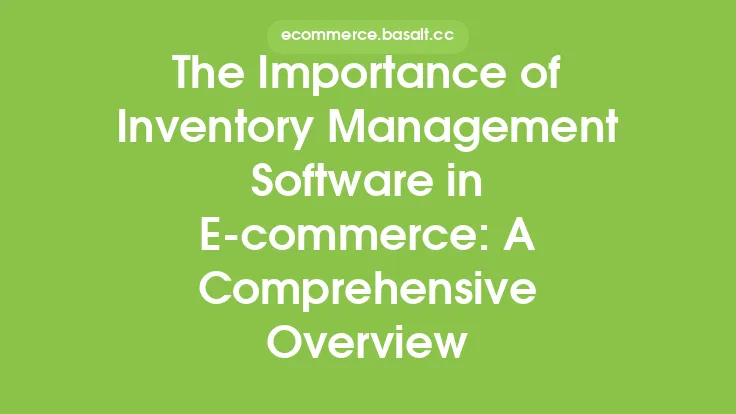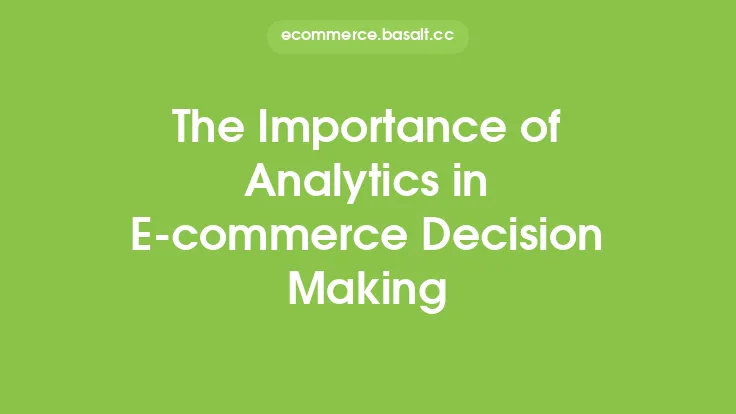In today's fast-paced and competitive e-commerce landscape, having a well-organized and efficient supply chain is crucial for businesses to stay ahead of the curve. One key aspect of achieving this is through supply chain visibility, which refers to the ability to track and monitor the movement of goods, services, and information throughout the entire supply chain. This transparency enables businesses to make informed decisions, respond to disruptions, and ultimately provide better customer service. Supply chain visibility is not just a luxury, but a necessity for e-commerce companies that want to build trust with their customers, reduce costs, and increase their overall competitiveness.
What is Supply Chain Visibility?
Supply chain visibility is the ability to access and share information about the supply chain in real-time, from the raw materials stage to the delivery of the final product to the customer. This includes tracking the location, status, and condition of goods, as well as monitoring inventory levels, shipping schedules, and other relevant data. With supply chain visibility, businesses can identify potential bottlenecks, anticipate delays, and take proactive measures to mitigate risks and ensure that products are delivered to customers on time and in good condition.
Benefits of Supply Chain Visibility
The benefits of supply chain visibility are numerous and far-reaching. For one, it enables businesses to respond quickly to changes in demand or supply, which can help to reduce stockouts, overstocking, and other inventory-related issues. Supply chain visibility also allows businesses to track the movement of goods in real-time, which can help to prevent losses due to theft, damage, or misplacement. Additionally, supply chain visibility can help businesses to improve their customer service by providing accurate and up-to-date information about the status of orders, which can help to build trust and loyalty with customers.
How to Achieve Supply Chain Visibility
Achieving supply chain visibility requires a combination of technology, processes, and collaboration. Some of the key strategies for achieving supply chain visibility include implementing track-and-trace systems, using data analytics and business intelligence tools, and establishing partnerships with suppliers and logistics providers that share data and information. Businesses can also use technologies such as RFID, GPS, and IoT sensors to track the movement of goods and monitor inventory levels in real-time. Furthermore, cloud-based supply chain management platforms can provide a single, unified view of the supply chain, enabling businesses to access and share information across different departments and locations.
Challenges and Limitations
While supply chain visibility is a critical component of e-commerce success, there are several challenges and limitations that businesses may face when trying to achieve it. One of the main challenges is the complexity of modern supply chains, which often involve multiple suppliers, manufacturers, and logistics providers. This can make it difficult to track and monitor the movement of goods, especially if different parties are using different systems and technologies. Additionally, supply chain visibility requires a high degree of collaboration and data sharing, which can be difficult to achieve, especially if businesses are working with multiple partners and stakeholders. Finally, implementing supply chain visibility solutions can require significant investments in technology and infrastructure, which can be a barrier for small and medium-sized businesses.
Best Practices for Implementing Supply Chain Visibility
To overcome the challenges and limitations of supply chain visibility, businesses should follow several best practices when implementing visibility solutions. First, they should start by defining their visibility goals and objectives, and identifying the key performance indicators (KPIs) that they want to track. Next, they should assess their current supply chain infrastructure and identify areas where visibility is lacking. Businesses should also consider implementing a cloud-based supply chain management platform, which can provide a single, unified view of the supply chain and enable real-time tracking and monitoring. Finally, businesses should establish partnerships with suppliers and logistics providers that share data and information, and invest in technologies such as RFID, GPS, and IoT sensors to track the movement of goods and monitor inventory levels.
Conclusion
In conclusion, supply chain visibility is a critical component of e-commerce success, enabling businesses to track and monitor the movement of goods, services, and information throughout the entire supply chain. By achieving supply chain visibility, businesses can respond quickly to changes in demand or supply, reduce costs, and improve customer service. While there are several challenges and limitations to achieving supply chain visibility, businesses can overcome these by following best practices such as defining visibility goals and objectives, assessing current infrastructure, and implementing cloud-based supply chain management platforms. By prioritizing supply chain visibility, e-commerce businesses can build trust with their customers, reduce costs, and increase their overall competitiveness in the market.





